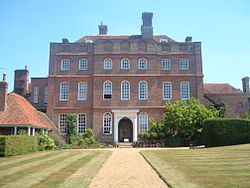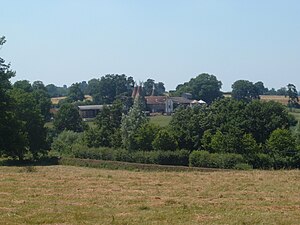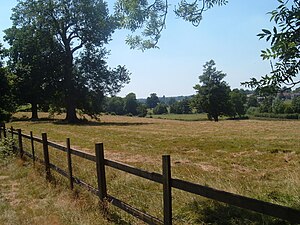Finchcocks
| Finchcocks | |
|
Kent | |
|---|---|
 View of the rear of the house, from the garden | |
| Location | |
| Location: | 51°6’8"N, -0°25’38"E |
| Village: | Goudhurst |
| History | |
| Built 1725 | |
| Georgian | |
| Information | |
Finchcocks is an early Georgian manor house in Goudhurst, Kent. For 45 years it housed a large, visitor-friendly museum of historical keyboard instruments, displaying a collection of harpsichords, clavichords, fortepianos, square pianos, organs and other musical instruments. The museum was run by the owners of the house, Richard and Katrina Burnett.
The house
The house was built in 1725 and named after the family who lived on the site in the 13th century. It is noted for its brickwork and has a dramatic front elevation attributed to Thomas Archer. It is located in 13 acres of grounds. There is parkland to the front and a garden to the rear with wide lawns, mature shrub borders, an orchard for wild flowers, and a walled garden. There are extensive views over the Kentish landscape of park, farmland, and hop-gardens.
The house, with its high ceilings and oak panelling, provides an ideal setting for music performed on period instruments; the house and instruments have been used regularly for recordings by leading exponents of early music such as Trevor Pinnock, Simon Preston and Nigel North. There is also a jazz club which was founded by Alastair Laurence of the Broadwood Piano company and was developed by Roan Kearsey-Lawson into a premier jazz venue where international artists have appeared including Frank Holder and Duncan Lamont. The club has also been featured on BBC One television.
In 2016, Finchcocks was bought by Neil and Harriet Nichols, with the intention of using it both as a family home and finding a way to continue the music at Finchcocks, through offering residential piano courses for adults of all abilities.
The Finchcocks collection
Finchcocks was acquired by Richard Burnett, a fortepianist, in 1970. The Adlam Burnett workshop (founded by Derek Adlam and Richard Burnett) was set up at the house and enabled instrument makers to produce copies of historical keyboard instruments in an ideal environment, learning from the construction of many originals. The building housed the Katrina and Richard Burnett collection of over 100 historical keyboard instruments; about forty of which were fully restored to playing condition. These could be seen and heard whenever the house was open to the public; it was one of the few collections of historical instruments at which people were welcome to play them themselves. With the Burnetts' retirement in 2015, the museum closed and many of its instruments were auctioned off for charity.[1] The auction catalogue[2] documented the instruments meticulously and in the auction many fetched two or three times the estimated prices. A total of £835,462 was raised from the sale of the collection.[3]
There is also a collection of musical pictures, prints and an exhibition on the theme of London's 18th-century pleasure gardens such as Vauxhall and Ranelagh Gardens.
Historical instruments in the collection

Clavichords
- Lindholm and Söderström: unfretted, 1806
- Georg Friedrich Schmahl: fretted, 1807
Harpsichords
- Joachim Antunes: single manual, 1785
- Thomas Blasser: double manual, 1744
- C.A.: bentside spinet, c.1700
- Fr. Ant. L.: single manual, 1716
- Gregori: single manual, c.1697
- Onofrio Guarracino: virginal, 1668
- Jacob Kirckman: double manual, 1756
- Joseph Mahoon: bentside spinet, 1742
Organs
- Anon: chamber organ, c.1680; chamber organ, c.1790; miniature free-reed organ, c.1860
- Alexandre Père et Fils: harmonium, 1859
- Autophone Company: cob organ (portable free-reed barrel organ), c.1885
- John Avery: chamber organ, 1792
- William Ayton: barrel organ, c.1800
- John Byfield: chamber organ, 1766
- Longman and Broderip: barrel organ, c.1790
Pianos
- Anon: portable square piano, c.1815; lyre piano (possibly Schleip, Berlin), c.1825; domestic barrel piano, 19th century
- Gustaf and Wilhelm Andersson: barrel piano, c.1890
- Bayes and Company: square piano, 1793
- Frederick Beale: upright euphonicon, c.1842
- Adam Beyer: square piano, 1777
- John Brinsmead and Sons: upright, c.1855
- John Broadwood and Son: grand, 1792; square, 1795; square, 1798; grand, 1801; square, c.1805
- John Broadwood and Sons: grand, c.1810; square, c.1820; grand, 1823; cabinet upright, c.1830; grand, 1846; square, 1858; grand, 1859; upright, c.1870
- Muzio Clementi and Company: grand, c.1800; upright grand, 1804; square, c.1815; square, c.1815; square, c.1815; grand, c.1815; grand, c.1821; grand, 1822; cabinet upright, c.1825; cabinet upright, c.1825
- Collard and Collard: square, c.1835; grand, c.1835; grand, c.1840
- William Edwards: cabinet upright, c.1825
Another view from Finchcocks - W.J. Ennever and Son: upright, c.1850
- Sébastien Érard: square, 1792
- Erard Frères: grand, 1801
- Erard: upright, c.1860; grand, 1866
- Johann Fritz: grand, c.1815
- Christopher Ganer: square, c.1780; square, 1784
- Conrad Graf: grand, c.1820; grand, 1826
- Crang Hancock: transverse grand, 1779
- Carl Henschker: grand, c.1840
- Mathias Jakesch: grand, 1832
- Jones, Round and Company: upright grand, c.1810
- William Kearsing: square, c.1830
- Knowles and Allen: square, c.1805
- Sebastian Lengerer: grand, 1793
- Longman, Lukey and Company: square, c.1780
- Frederick Mathuschek: square, 1873
- Sébastien Mercier: upright, 1831
- Henri Pape: upright piano-console, 1841; upright piano-console, 1843
- Ignace Pleyel et Compagnie: upright, c.1840; grand, 1842
- Michael Rosenberger: grand, c.1800
- Leopold Sauer: pyramid piano, c.1805
- William Southwell: upright square, c.1800
- Robert Stodart: grand, 1787
- William and Matthew Stodart: grand, 1802; square, 1807
- Johann Baptist Streicher: grand, 1867
- Anton Walter und Sohn: square, c.1800
- Wilson: square, 1789
- Robert Woffington: upright, c.1800
- Johannes Zumpe and Gabriel Buntebart: square, 1769
Others
- Anon: cylinder musical box with drum and bells, c.1895
- Busson: piano accordion, c.1850
- Chappell and Company: keyboard crystallophone (or 'pianino'), c.1815; digitorium, c.1870
- Paul Lochmann: symphonion (disc musical box), c.1895
- Thomas Machell and Sons: dulcitone, c.1920
- J Tait: angelica (musical glasses), c.1815
Related publications
- Burnett, R: English Pianos at Finchcocks, Early Music (1985)
- Burnett, K and R: Finchcocks Past & Present (2003)
- Dow, W: Finchcocks Collection, Catalogue: the Richard Burnett Collection of Historical Keyboard *Instruments (1989)
References
- ↑ "Finchcocks Musical Museum in Goudhurst set to close its doors". http://www.courier.co.uk/Pair-s-musical-museum-set-close-doors/story-28205410-detail/story.html. Retrieved 24 February 2016.
- ↑ "Drewaetts Catalogue: The Richard Burnett Collection". http://www.dreweatts.com/media/dreweatts/auctions/13949.pdf. Retrieved 13 May 2016.
- ↑ "Richard Burnett keyboard collection sells for £835k at auction". BBC News Online. 12 May 2016. http://www.bbc.co.uk/news/uk-england-berkshire-36273486. Retrieved 16 May 2016.
Outside links
- Finchcocks Musical Museum - official site
